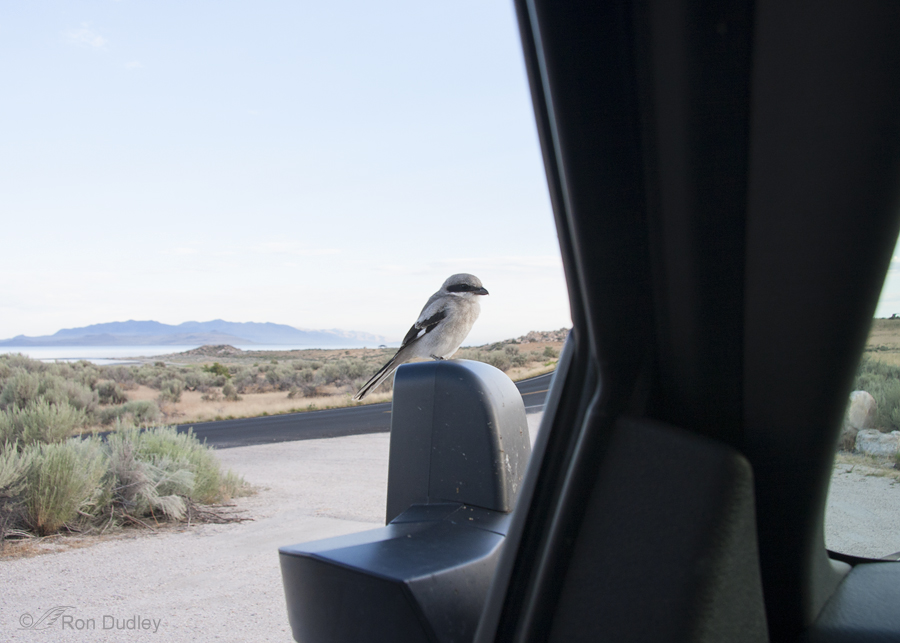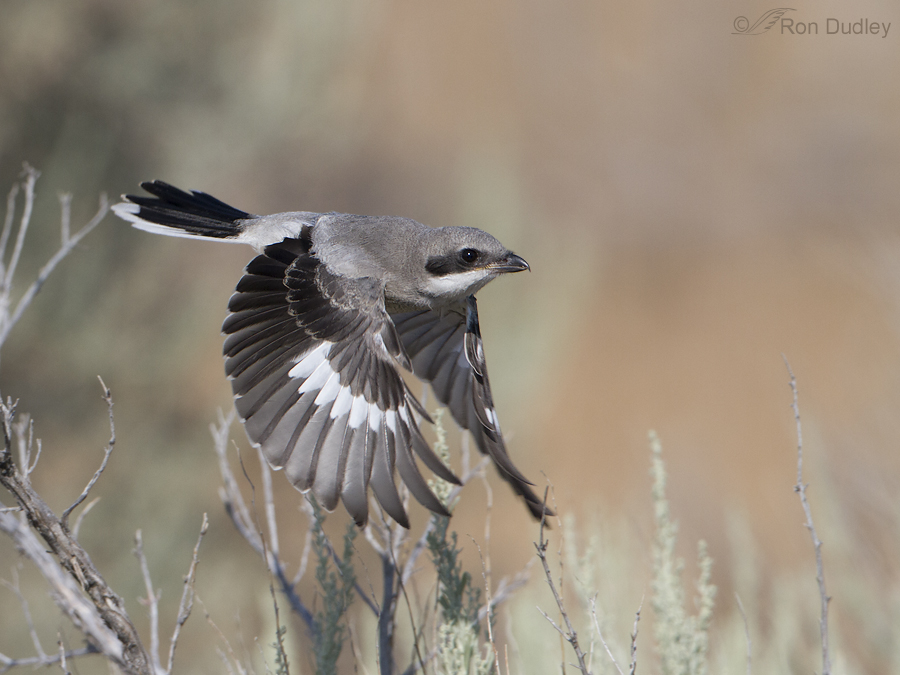Tag: lanius ludovicianus
Fledgling Loggerhead Shrike Begging For Food
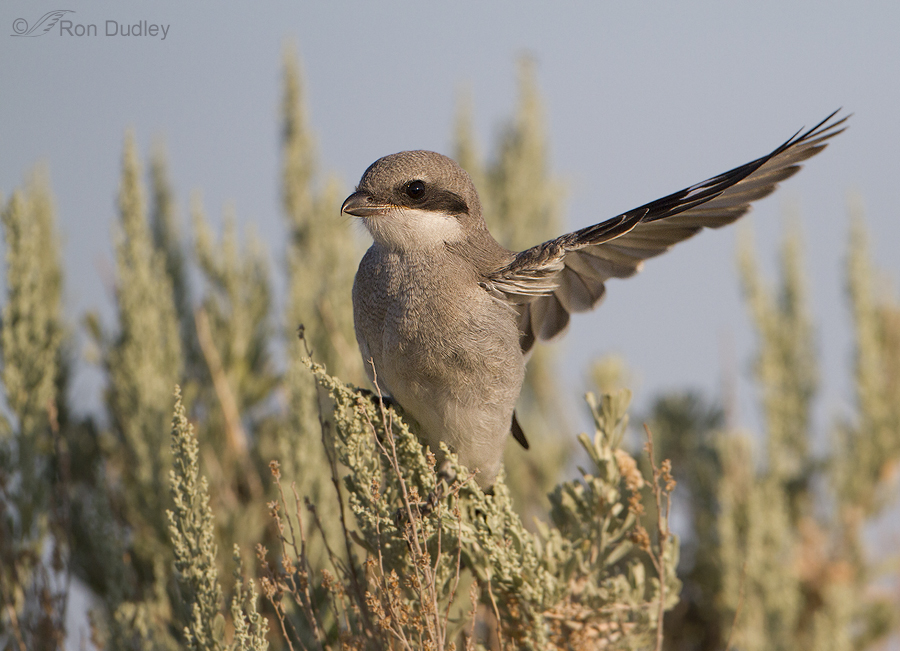
I photographed a family of very cooperative Loggerhead Shrikes last week on Antelope Island. The young birds had already fledged and were very actively exploring their world, strengthening their wing muscles by flying from perch to perch and testing a variety of objects for their potential food value.
And they were gutsy! Several times a juvenile landed on the tailgate of my pickup as you can see here.
A Shrike, A Deer Fly And A Feathered Photography Update
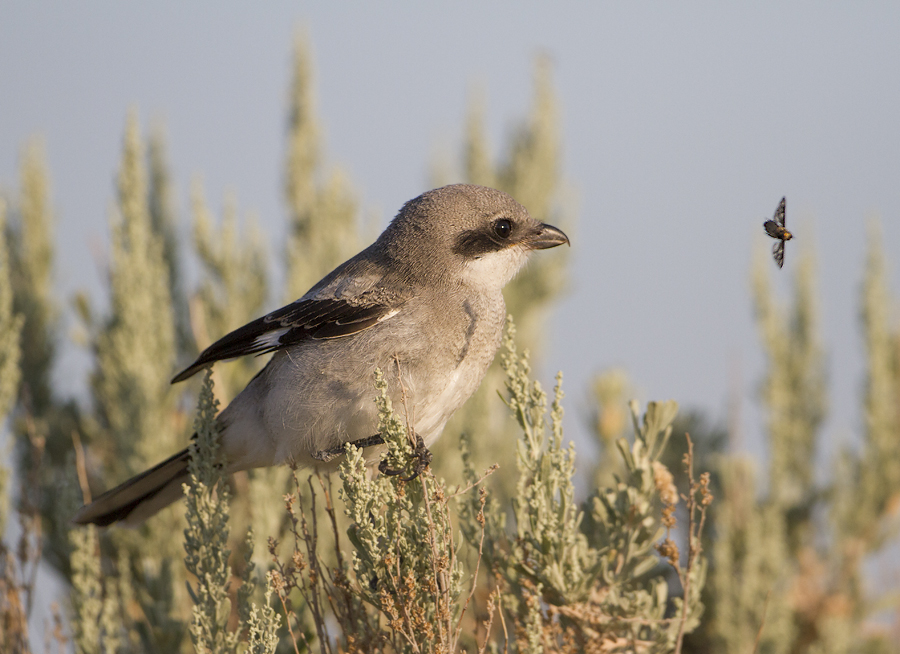
I thought this image was particularly interesting for several reasons.
This juvenile had been enthusiastically begging for food when a deer fly (I believe) unexpectedly appeared on the scene. A split second prior to this shot the bird had its wings out, its beak open and was squawking to be fed but the focus of its attention changed immediately when the biting insect appeared.
My Favorite Shrike Flight Shot
Juvenile Loggerhead Shrike Take-off
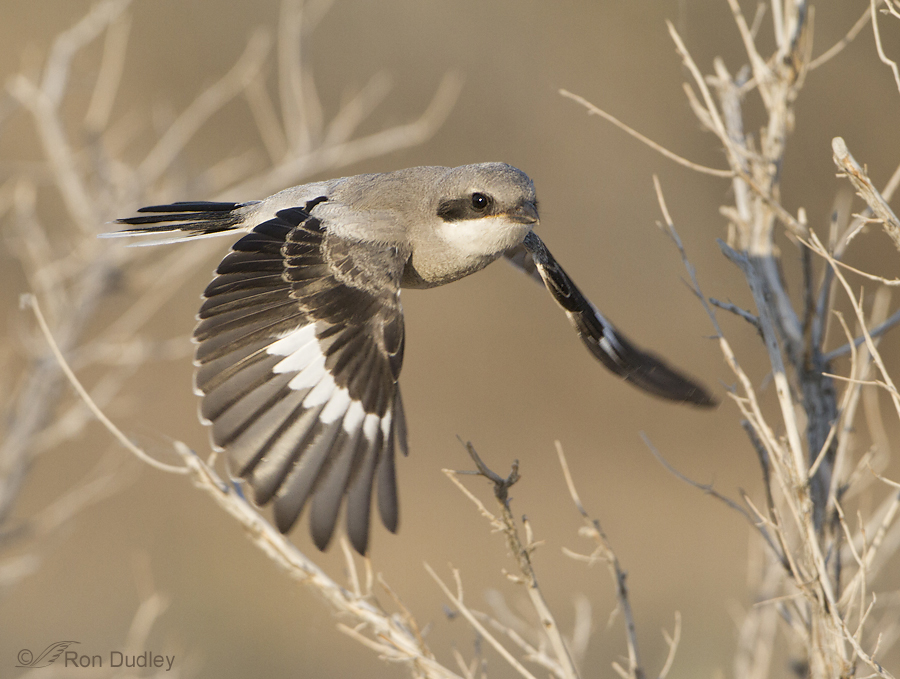
Many of the young Loggerhead Shrikes on Antelope Island have now fledged and are learning the ropes. They’re ornery, fun, fierce and fearless. Twice I’ve had one almost fly into my open pickup window, another one very nearly landed on my lens hood sticking out a window and yet another landed on the pickup itself.
Loggerhead Shrike – The Bill Of A Killer
I’ve never been able to get a really good look at both the hook and tomial teeth on the bill of a Loggerhead Shrike in any of my images. Until two days ago on Antelope Island…
A Shrike Partially Consumes Its Own Pellet
This post is documentary only. The images are not aesthetically pleasing. Loggerhead Shrikes produce a pellet from an insect meal only 35.5 minutes (on average) after consumption. This is an amazingly fast turn-around time (Short-eared Owls average 8.5 hours before a pellet is produced from their rodent prey). When shrikes are consuming insects and spiders their pellets consist of the indigestible chitinous exoskeletons of those arthropods. I’ve seen and photographed Loggerhead Shrikes ejecting pellets many times but what I photographed on this August morning was new to me. Because of the cluttered setting I was mostly only watching this juvenile through my lens (not photographing it) when I could tell it was about to chuck up a pellet. Every time I’ve observed this behavior in the past the pellet was ejected quickly and cleanly and simply fell to the ground. But this bird had a surprise for me. It caught the pellet in the tip of its beak… and manipulated it there for some time. Then it very deliberately mashed up the pellet and appeared to be swallowing parts of it as other smaller pieces fell to the ground. My guess would be that about half of the pellet was consumed as the other half fell away, though I can’t be absolutely certain that any of it was actually eaten because my view of what was happening was not always a clear one. I wish I knew what was really going on here. This is the only time I’ve ever seen a bird (of any species) manipulate a pellet after…
Warm vs Cool Light – Minutes Matter
Color temperature (white balance) can make a big difference in photography and nature photography is certainly no exception. I seldom manipulate white balance during processing and never do it if I’m confident that my camera has rendered the image to look like it did in the field. 1/000, f/7.1, ISO 640, 500 f/4, 1.4 tc, natural light, not set up or called in The natural colors of the Loggerhead Shrike are gray, black and white but those colors are affected by the temperature of the light. I photographed this bird on November 26, 2012 at 7:56 am, very soon after the sun had come up over the Wasatch Mountains. Notice the warm, golden tones on the grays and the whites of the bird, and on the perch. They can even be seen in the almost black beak. 1/000, f/7.1, ISO 640, 500 f/4, 1.4 tc, natural light, not set up or called in Just 20 minutes later, at 8:16 am, I photographed this shrike on a different perch. By then the sun was higher in the sky and the light was filtered through relatively thin clouds. I think the difference in color tone of the two images is dramatic. Even though nature photographers often prefer warmer colors in their images I’m not suggesting that either warmer or cooler colors are necessarily “better” than the other. I’m only saying that they can have a huge overall effect on the image. And that mere minutes matter. Ron
Loggerhead Shrike Attempting To Impale A Grasshopper
Shrikes are well-known for impaling their prey on sharp projections like thorns or barbed wire as a means of food storage – they’re called “butcher birds” for good reason. I suspect the behavior to do so is innate but to become skilled at it takes practice. This past summer I found this Loggerhead Shrike on a fence on the Montana farm where I grew up. It had already captured the grasshopper when I arrived on the scene. First, my standard disclaimer for behavioral sequences. This bird was strongly sidelit so I seldom got a catch light and the light was harsh. To compensate, I did more processing with these images than I normally do because my intent is to show the behavior as well as possible, even though image quality suffered from the processing. Almost immediately I could see that the shrike was going to attempt to impale the grasshopper on the barb just below and in front of the beak of the bird. Impaling prey apparently isn’t an easy task. From all the contortions the bird went through… I’d assume that part of the problem was the awkward angle the shrike was at… to get proper leverage to complete the task. At one point the bird nearly fell off the fence. After a few moments the shrike gave up, turned its back on me with the grasshopper between its legs (and a gob of grasshopper on its bill) and seemed to contemplate what…
Shrikes And A Lesson For Me In Light
Birds on Antelope Island have been few and far between lately and yesterday was no exception. But a couple of Loggerhead Shrikes saved my morning and taught me yet another lesson in light. 1/1000, f/7.1, ISO 640, 500 f/4, 1.4 tc, natural light, not baited, set up or called in It was mostly cloudy on the island when we got there just as the sun was coming up over the mountains but there was a crack in those clouds that provided some very warm light for a few minutes just as we found this cooperative shrike. The golden light provides colors to the bird and perch – an effect that I like, especially with the dark storm clouds in the background. 1/500, f/7.1, ISO 640, 500 f/4, 1.4 tc, natural light, not baited, set up or called in I was only able to get off a few shots before the shrike flew to another perch, which gave me side light on the bird. This is a tricky lighting situation. When the bird was facing left into the sun the bright whites on the breast and neck “blew out” (too bright with no detail) and the shadows on the back of the shrike were too dark. But when it turned to its right and looked over its shoulder at me the exposure worked much better. The problem with this pose was getting both light in the eye and good eye contact. This image was one of the few that worked. I like the contrasting cool and warm tones on the shrike….
Loggerhead Shrike Take-offs
One of my current projects is take-off shots of Loggerhead Shrikes and I’m finding it to be unexpectedly difficult to get the quality I want. Take-offs of small birds are challenging by definition but I have quite a few that I like of other species so I’m a bit surprised that I’m struggling so with the shrikes. This past week I’ve had at least some success and these two are the best of the lot so far. 1/3200, f/6.3, ISO 500, 500 f/4, 1.4 tc On Tuesday morning this shrike gave me nice eye contact as it launched from its perch and I had good light and a clean background but I’m a bit surprised that the wings aren’t sharper. I doubt that it’s motion blur at 1/3200 and I was far enough away from the bird that I thought f/6.3 would give me more depth of field than this. Live and learn… 1/2500, f/7.1, ISO 500, 500 f/4, 1.4 tc Two mornings later I was photographing this shrike perched when an insect that interested it flew overhead. The bird has its eye on the bug as it’s taking off. This has been the best year on Antelope Island for Loggerhead Shrikes that I can remember as they seem to have had very good success so far in raising their broods. And with the plethora of huge orb-weaver spiders just coming on, things should only get better out there for shrikes. They love to eat those nasty looking spiders and feed them to their chicks. Which should mean more practice for me…
Fledgling Loggerhead Shrike Learning The Ropes
Yesterday we came across this Loggerhead Shrike fledgling perched high and pretty in the early morning light. 1/500, f/8, ISO 640, 500 f/4, 1.4 tc A few minutes after this shot was taken the bird flew off so we decided to look for more opportunities elsewhere and left the area. 1/2000, f/6.3, ISO 500, 500 f/4, 1.4 tc Just before we quit shooting for the day we decided to look for the fledgling again in the same area as before. We found two of them this time – one flew off almost immediately but this one allowed us some close observations for about 25 minutes. By this time of the morning the bird was side-lit in most situations but we got to see some interesting behaviors. Typical of youngsters this one was curious about its surroundings and spent quite a bit of time exploring the greasewood bush it was in. Here it is about to half hop/half fly to the twigs in the upper left of the frame. 1/2500, f/6.3, ISO 500, 500 f/4, 1.4 tc Several times it picked off one of the drier greasewood buds and played with it for a while. 1/2500, f/6.3, ISO 500, 500 f/4, 1.4 tc But a parent coming in with food always got the full attention of the fledgling. In this image one of the adults is delivering a grasshopper to the begging young bird – you can just see the top of the parents head at the bottom of the frame as it works its way…
Shutter Speed and Take-off Shots
Just a single image today, to illustrate a lesson I’ve learned before but “relearned” yesterday. I shoot lots of birds at take-off, particularly raptors. For those larger subjects relatively slow shutter speeds will usually freeze the motion, even in the wings. Typically, 1/1200 or 1/1600 will do just that. 1/3200, f/5.6, ISO 500, 500 f/4, 1.4 tc, cloned out an OOF sunflower stalk to the right of the bird So yesterday after I’d taken a few perched shots of this shrike I set up for a take-off since it was facing to my right and I figured it would take off in that direction, giving me both good light and a take-off posture that would require relatively little depth of field so f/5.6 would suffice. Then I noticed that I had a shutter speed of 1/3200 and I remember thinking that might be a little excessive and I should dial back to f/ 6.1 for slightly more DOF and less shutter speed. But I knew that if I took a moment to change my settings the bird would choose that instant to launch and I’d miss the shot. So I stuck with my settings. I’m glad I did. Wing motion in these little birds is incredibly fast! Here, even 1/3200 didn’t completely freeze the wings. Don’t get me wrong – a little motion blur in wings of birds in flight isn’t an issue with me and I’m perfectly happy with this image the way it is. But for my tastes I’m glad there’s no more motion blur than there is. Ron
A Few Recent Loggerhead Shrikes
There’s always a few Loggerhead Shrikes that winter-over on Antelope Island and I find them to be fascinating subjects. Their approachability is very unpredictable but occasionally they’ll allow me to get close, especially when it’s very cold in the mornings or if they’re about to hack up a pellet. These are images I was able to get in the last few weeks. ***Note: The last image in this post is graphic. If your sensibilities might be offended by such a photo please stop scrolling before you get to the last (6th) image. 1/3200, f/5.6, ISO 500, 500 f/4, 1.4 tc This bird was practicing its springtime melodic repertoire a few weeks early (image taken on 2/5/12). It was a relatively warm, sunny morning and it was singing its little heart out (if you can call shrike calls “singing”). 1/2000, f/6.3, ISO 400, 500 f/4, 1.4 tc With their black masks these shrikes always remind me of little bandits and they have an attitude to go along with that perception. They get their name from their unusually large head (loggerhead means “block head”). 1/8000, f/5.6, ISO 500, 500 f/4, 1.4 tc I like the soft, even light and the setting in this image even though the twigs in front of the bird may not be ideal for some. 1/640, f/7.1, ISO 640, 500 f/4, 1.4 tc I’m including this shot just for fun. I liked the fluffy, relaxed pose to go along with the yawn. 1/1250, f/7.1, ISO 500, 500…
Shrikes, Pellets and Photographer’s Frustrations
For about three years now one of my photography goals has been to get a series of quality shots showing a Loggerhead Shrike regurgitating a pellet. My requirements were that the images must be sharp with good detail and light, there must be no significant distractions or clutter to interfere with the behavior, there should be light in the eye (a catch light) and the last shot must show the pellet after it has left the birds mouth. This post is a progress report of sorts on how I’ve fared with the goal. I’ll include some lessons I’ve learned and mistakes I’ve made so I hope you’ll bear with me through a few less than ideal images which help to illustrate some of those lessons. 1/1250, f/8, ISO 640, 500 f/4, 1.4 tc This was my first image of a shrike ejecting a pellet (3/3/10). I didn’t anticipate it happening and wasn’t even sure what was going on until I processed the image. I got two almost identical shots that showed the pellet in the mouth and missed the pellet as it was ejected (I think I remember my buffer filling up just about then). I was also too far away for good image quality – this is a large crop. 1/3200, f/6.3, ISO 500, 500 f/4, 1.4 tc On the next opportunity (8/5/11) I was frustrated by obstructing branches and a poor light angle. While this young bird was ejecting the pellet it was facing mostly toward me which put its face and the pellet in shadow. Then the juvenile did something completely unexpected…


